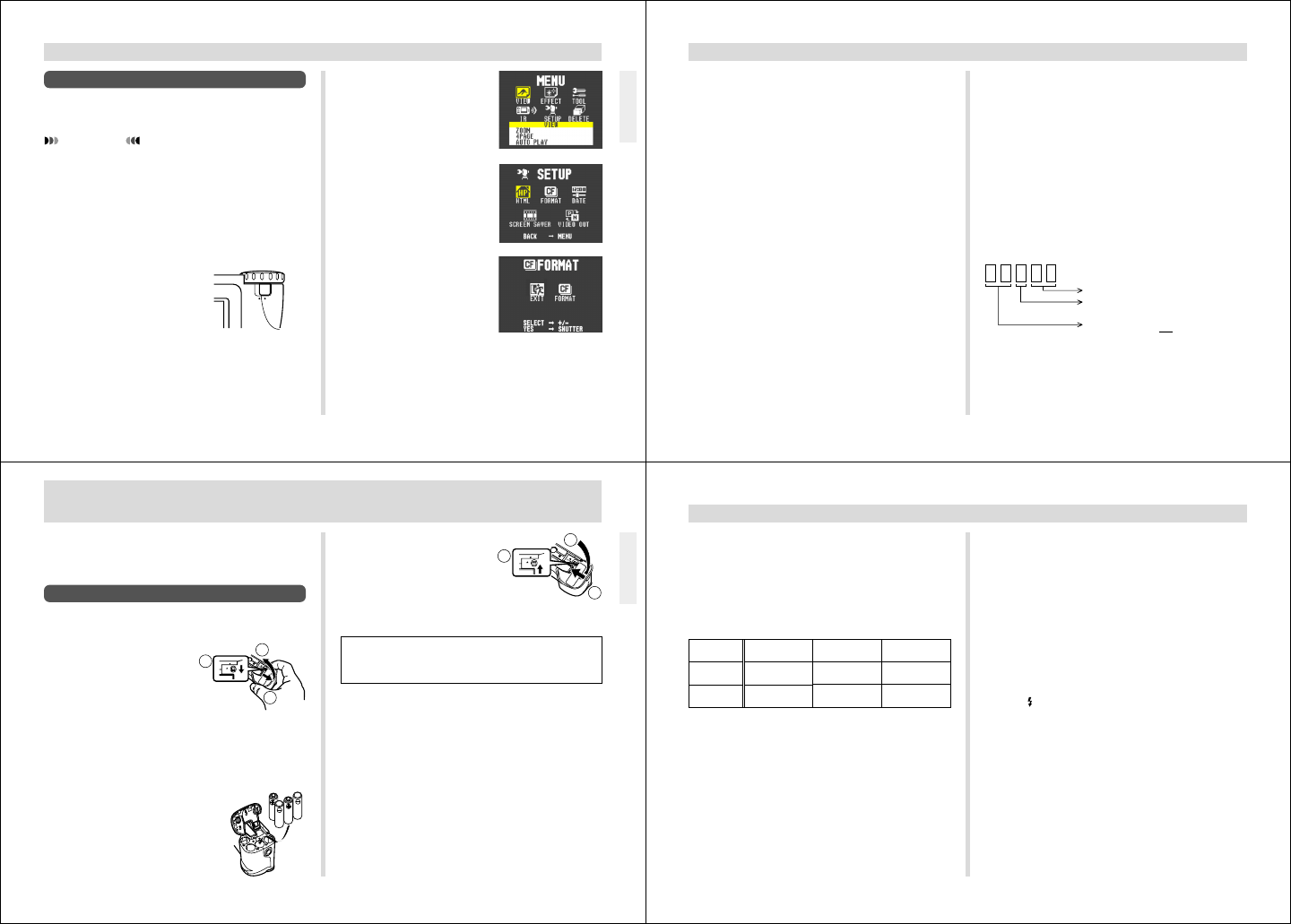
25
2.
Press MENU.
3.
Use [+] and [–] to select
SETUP, and then press
the shutter button.
4.
Use [+] and [–] to select
FORMAT, and then press
the shutter button.
5.
Use [+] and [–] to select FORMAT, and then
press the shutter button.
Formatting a Memory Card
You can format a memory card to delete all of the data
stored on it.
IMPORTANT!
• Formatting a memory card deletes all images on the
card, even if some or all of the images are protected.
• Data deleted by a memory card format operation can-
not be recovered! Be sure to carefully check and con-
firm that you no longer need the data stored in a
memory card before formatting it.
To format a memory card
1.
Slide the Function Switch
to PLAY.
MEMORY CARDS
REC PLAY
26
MEMORY CARDS
Memory Card Folder Precautions
• Folders (directories) are automatically created if the card
you are using does not already have similarly named fold-
ers (page 84).
• Up to 250 images can be stored in a single folder. Though
it is possible to put more than 250 images into a folder on
your computer, the camera will not display images past
250.
• Image files in camera memory are assigned names made
up of the date (first five characters) plus a three-digit num-
ber and the extension JPG. Names do not change when
you move or delete folders.
Memory Card Precautions
• Images cannot be recorded with this camera unless a
memory card is installed in it.
• Be sure to use only CASIO brand CompactFlash cards.
Proper operation with other memory cards is not guaran-
teed.
• Static electricity, electrical noise, and other electrical phe-
nomena can cause corruption or even total loss of the
data stored on a memory card. Because of this, you
should always make backup copies of important images
on other media (magnetic optical disk, floppy diskette,
computer hard disk, etc.).
• Memory card problems can be corrected by reformatting
the memory card (page 122). Reformatting a memory card
deletes all images stored on the card, but you can use a
computer to copy the images you want to keep to the
computer’s hard disk before reformatting your card. If you
plan to be recording images where you do not have ac-
cess to a computer, it is a good idea to take along an extra
memory card or two just in case you experience an unex-
pected memory card problem.
< Example >
001. JPG
Day: 01 to 31
Month: 1 to 9, A, B, C
(OCT) (NOV) (DEC)
Year: 98, 99, 00, 01 to 49
(2000)
27
POWER SUPPLY
LOCK
3
2
1
LOCK
3
2
1
The camera features a two-way power supply that lets you
use either batteries (AA-size alkaline, lithium or Ni-MH) or
household AC current.
To load batteries
Be sure that camera power is turned off whenever loading or
replacing batteries.
1.
On the bottom of the
camera, slide the battery
compartment cover lock
towards the front of the
camera (
11
11
1) to release
the cover.
2.
Grasping both sides of
the battery compartment
cover, swing it open (
22
22
2
33
33
3
).
3.
Load batteries so their
plus (+) and minus (–)
ends are facing as
shown in the illustration.
4.
Close the battery com-
partment cover (
1 21 2
1 21 2
1 2
),
and then slide the bat-
tery compartment cover
lock towards the back of
the camera to lock the
cover in place (
33
33
3
).
Be sure to use alkaline, lithium or Ni-MH batteries.
Never use manganese batteries (see precautions on
the next page).
• Make sure the battery compartment cover is locked se-
curely. Failure to do so can result in the cover opening,
creating the danger of personal injury and corruption of
image data.
28
POWER SUPPLY
Standard Battery Life
This camera can be powered using AA-size alkaline, lithium
or Ni-MH batteries.
The battery life reference values given below indicate the
amount of time at standard temperature (25°C) until power
automatically turns off due to battery failure. They do not
guarantee that batteries will perform the amount of service
indicated. Battery life is reduced by low temperatures and
continued use.
• The above figures are approximations only.
• The above guidelines are based on the following battery
types:
Alkaline: MX1500 (AA) DURACELL ULTRA
Lithium: Fuji Film
Ni-MH (Nickel-metal hydride): CASIO NP-H3
• Battery life varies with brand.
• Figures are based on continuous recording under the fol-
lowing conditions.
Flash turned off
One zoom slider switching between T (Telephoto) and W
(Wide-angle)
Regardless of use of the camera’s flash, zoom function,
turning on and off the POWER Switch, as well as other oper-
ating conditions may affect the above values.
● About rechargeable batteries
• Use only the nickel-metal hydride batteries (NP-H3) that
are available from your dealer as options for this camera.
Proper camera operation is not guaranteed when other re-
chargeable batteries are used.
• Be sure to keep all four batteries together as a set at all
times, for both charging and powering the camera. Mixing
batteries from different sets can shorten overall battery life
and cause malfunction of the camera.
• Rechargeable batteries cannot be charged while they are
loaded in the camera.
Nickel-metal hydride Batteries (4-battery set)/Quick
Charger Set BC-1HB4
Nickel-metal hydride Batteries (4-battery set) NP-H3P4
● Tips for Prolonging Battery Life
• Use the
button to turn off the flash when you are not using
it.
AA-size Ni-MH
110 minutes
360 shots
AA-size Alkaline
Batteries LR6
80 minutes
210 shots
Type of
Operation
Continuous
Playback
Continuous
Recording
AA-size Lithium
Batteries FR6
190 minutes
590 shots


















